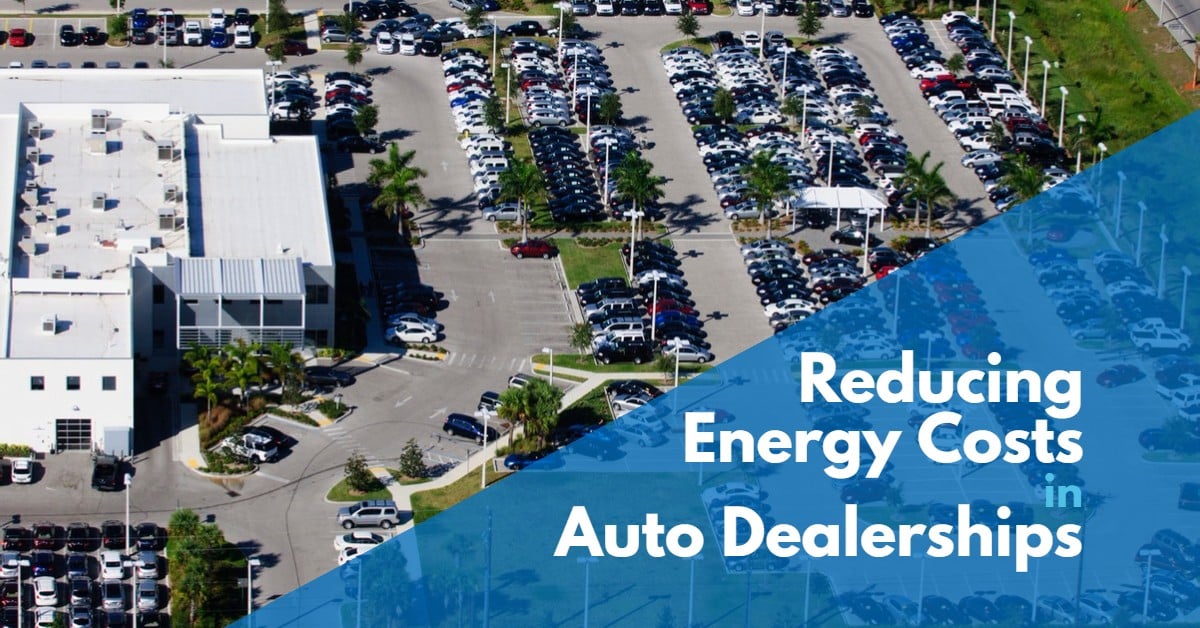
 Posted by Pam Hoddinott
Posted by Pam Hoddinott Reducing auto dealership overhead costs is an essential way to boost profits. Lowering energy consumption should be a key consideration when looking to cut costs. Energy is the third-highest overhead expenditure for automobile dealerships, according to E Source.
ENERGY STAR states that auto dealerships use, on average, more energy per square foot than a typical office building. There is no question that auto dealerships are an energy-intensive industry. To break it down, car dealership facilities consume about 110 kBTU per square foot, compared to office space at 93 kBTU.
The good news is that the best opportunity for significant energy savings can be found in an area of highest consumption – lighting and HVAC systems. A lighting upgrade can increase building aesthetics and reduce energy consumption while still maintaining lighting quality, safety and security, and a superior customer experience. HVAC improvements will increase customer and employee comfort alike. It should come as no surprise that lighting, heating, and cooling all play a big part in enhancing auto dealership’s showroom floors and making customers feel comfortable.
Energy management is important to reduce energy consumption. With such high energy usage at auto dealerships, it is easy to make a case for energy efficiency. Consider the following:
There are many improvements an auto dealer can implement that will make a significant impact in cutting energy use within a short period of time.
Lighting Upgrade
Long hours of operation and heavy use of interior and exterior lighting adds up to significant energy use. A LED Lighting Upgrade or LED Lighting Retrofit can cut your auto dealership’s energy bill with little effort. Lighting upgrades and retrofits can be implemented with little cost and most improvements pay for themselves quickly.
Proper lighting provides greater customer appeal and can enhance sales. Automobiles should sparkle and shine under proper lighting and invite customers to explore the vehicles. LED lights provide a long life of use with little or no maintenance. With LED lighting, automobile dealerships don’t have to deal with burned out bulbs.
Similarly, exterior lighting is just as important. Customers are drawn to a well-lit dealership lot. Proper exterior lighting on a car lot attracts customers to view inventory, provides a pleasant customer experience, and also serves as security by being a theft deterrent. A well-designed lighting layout of a parking lot will ensure there are no dark spots. Exterior LED lighting reduces energy use and cuts costs.
Don’t forget to upgrade the lighting in the back of the house at your auto dealership. Proper lighting is highly important in the Parts & Service area, Body Shop area, Paint Booths, and Detailing area. Employees can perform their daily operations in the safety of suitable lighting.
Other lighting options for automobile dealerships to consider that improve energy efficiency and cut costs are LED exit lights and occupancy sensors for low traffic areas.
Smart HVAC Upgrades
Proper heating, ventilating, and air-conditioning (HVAC) is essential to providing a comfortable and productive environment for dealership personnel and customers. An HVAC upgrade can make a substantial impact on optimizing the energy efficiency of an auto dealership. Smart HVAC solutions are available that use the latest technology to provide fan control on rooftop units. More efficient motors use less energy and variable frequency drives (VFDs) save energy by decreasing motor speed when full output is not needed. Considerable cost savings and enhanced heating and cooling performance can be achieved by implementing energy efficiency measures on HVAC equipment.
Programmable Thermostats
Installing programmable thermostats will also reduce energy costs at your auto dealership. Programmable thermostats allow you to set pre-programmed setbacks. Energy consumption – and your utility bills – will be cut if thermostats are set to adjust the temperature after hours and on holidays. You may want to consider smart thermostats for even more control over your energy bills. Smart thermostats allow you to change heating or cooling via a mobile phone or web application, as well as the option to track energy usage.
Incentives and Rebates
Auto dealers can save even more money on energy efficiency projects when it is paired with a rebate or incentive. Often, auto dealerships don’t realize that rebates and incentives are available on a variety of energy efficiency equipment or upgrades including LED lighting upgrades and HVAC upgrades. Rebates and incentives help reduce the cost of a project and can substantially improve the ROI. This improved payback can be advantageous in gaining approval to move forward with the energy efficient projects at your facility.
Summary
Any automotive business can easily drive energy savings by implementing energy efficient upgrades or new technology. According to the National Automobile Dealers Association, if all U.S. dealerships reduced their energy consumption by just 10 percent, they would save about $200 million in energy costs and cut about one million tons of carbon dioxide emissions every year.
All dealerships have the potential to reduce energy costs by at least 20 percent or more with the energy optimization approaches discussed above. What dealership wouldn’t want to start Making Energy an Asset® by reducing energy bills and boosting profits?
Chateau Energy Solutions Making Energy an Asset®
Ready to get started on the path to energy efficiency and sustainability?